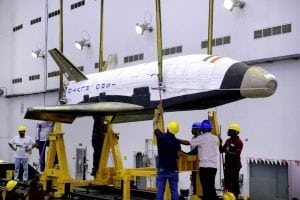Latest News
[Via Satellite 05-24-2016] The Indian Space Research Organization (ISRO) on May 23 flight tested India’s first winged body aerospace vehicle operating in a hypersonic flight regime. The mission flew a Reusable Launch Vehicle-Technology Demonstrator (RLV-TD) to test critical technologies such as autonomous navigation, guidance and control, a reusable thermal protection system and re-entry mission management, all of which were successfully validated according to the agency.
During the experimental mission, an HS9 solid rocket booster carrying the RLV-TD lifted off from the First Launch Pad at Satish Dhawan Space Center, Sriharikota, India. After a 91.1 second flight, HS9 burn out occurred, following which both HS9 and the RLV-TD mounted on its top coasted to a height of about 56 km. At that height, RLV-TD separated from HS9 booster and further ascended to a height of about 65 km. From this peak altitude, the RLV-TD began its descent followed by atmospheric re-entry at around Mach 5, gliding to a defined landing spot over the Bay of Bengal at a distance of about 450 km from Sriharikota.
Total flight duration from launch to landing of this mission lasted about 770 seconds. The Indian Coast Guard and National Institute of Ocean Technology (NIOT) supported the mission by taking mid sea wind measurements and providing ship born telemetry for this mission, respectively.
Get the latest Via Satellite news!
Subscribe Now